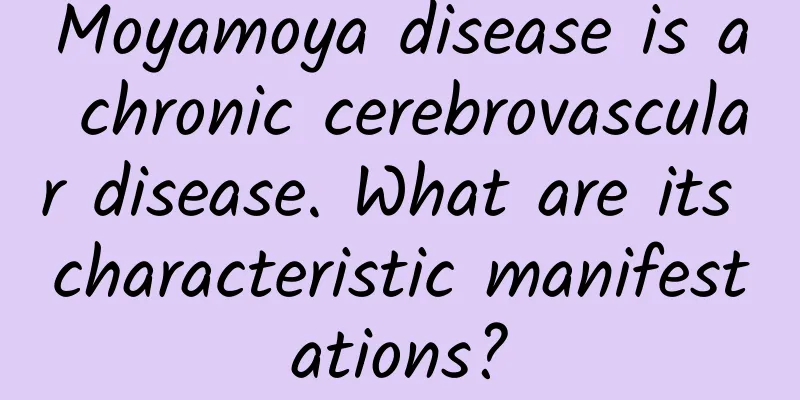Moyamoya disease is a chronic cerebrovascular disease. What are its characteristic manifestations?

|
Moyamoya disease is a rare cerebrovascular disease. During cerebrovascular examination, the abnormal vascular network at the site of disease appears "smoke-like", so it is called moyamoya disease. Moyamoya disease increases the risk of stroke in patients. What are the characteristics of moyamoya disease in daily life? 1. Age: There are two peak incidence periods of moyamoya disease, namely children (under 10 years old) and middle-aged people (40-50 years old). Patients in the high-risk age group are recommended to go to the hospital for cerebrovascular examination if they have frequent stroke symptoms with unknown causes. Second, the patient is young, but has frequent cerebral infarction and cerebral hemorrhage, sometimes even alternating, and the cause has never been found. Cerebral infarction and cerebral hemorrhage are common diseases in the elderly, and the risk of cerebral infarction or cerebral hemorrhage in young patients is very small. For some reason, the large blood vessels in the brain of patients with moyamoya disease gradually narrow or even occlude, and compensatory blood vessels are formed around them. However, the growth rate of compensatory blood vessels is lower than the occlusion rate of large blood vessels, resulting in insufficient blood supply to the brain, and patients are prone to transient cerebral ischemia and cerebral infarction. On the other hand, compensatory blood vessels are fragile and prone to rupture and bleed. When blood pressure increases, blood vessels cannot withstand the pressure, which can easily lead to bleeding. Transient cerebral ischemia, cerebral infarction and cerebral hemorrhage are the main symptoms of moyamoya disease. If moyamoya disease is not treated, the blood supply to the patient's brain will not be improved, and stroke will occur frequently. Therefore, when patients have this condition, it is recommended to go to the hospital for examination in time. If there is any abnormality, timely treatment should be carried out to reduce the risk of disability of patients. 3. Abnormal behavior of the child before and after: The child used to like outdoor sports, study hard, and have good grades. Now the child often stops running and suddenly has transient numbness and weakness in the limbs. Over time, the child is unwilling to go out for outdoor activities. In class, the child begins to lose concentration, memory declines, and academic performance plummets. 4. Abnormal imaging images: If the patient has the above symptoms and goes to the hospital for a cerebrovascular examination, it is found that the blood vessels at the patient's lesion appear "smoke-like", which means the patient can be diagnosed with moyamoya disease. |
<<: Ladies who love beauty, do you know how to choose products to lighten spots?
Recommend
Treatment for leucorrhea with blood and no odor
Leucorrhea with blood but no odor is a disease th...
What medicine should I use for itchy caesarean section scars?
Scars are a relatively common condition, and ther...
What to do if milk is not flowing after 3 days of delivery
For new mothers, breastfeeding is a novel experie...
Can I use salt hot compress to treat pain during menstruation?
Using salt for hot compress is a very common trea...
Why do women lose their hair?
I believe that every female friend has encountere...
[Tumor Prevention and Treatment] EB virus positive ≠ nasopharyngeal carcinoma
Nasopharyngeal carcinoma is one of the most commo...
What are the types of barbecue? How to prevent weight gain by eating barbecue?
Barbecue refers to the process of grilling meat a...
How to adjust if you want to have a second child at the age of 40
If a woman wants to get pregnant after she is 35 ...
Can I eat Atractylodes macrocephala during menstruation?
Most female friends become very sensitive during ...
The truth behind a woman's miscarriage made me cry after reading it
Nowadays, more and more women are experiencing ac...
What to do if your breasts are dull and painful
Human beings are a whole, and it is unavoidable t...
Is it better for pregnant women to drink low-fat milk or whole milk?
While people rely on milk to supply the necessary...
Why do women have a strong odor in their private parts?
I believe that many women have experienced the pr...
How to eat during exams? Six tips to stay safe
As the days of the college entrance examination a...
Can drinking brown sugar water during menstruation really relieve dysmenorrhea? The truth is different from what you think
Rumor: "During menstruation, drinking brown ...









